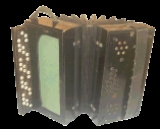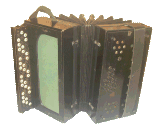
Schrammel accordion
Encyclopedia

Accordion
The accordion is a box-shaped musical instrument of the bellows-driven free-reed aerophone family, sometimes referred to as a squeezebox. A person who plays the accordion is called an accordionist....
with a melody (right hand) keyboard in the chromatic B-Griff system and a twelve-button diatonic bass keyboard. It is named for a traditional combination of two Violins, Accordion and Contrabass known as Schrammelquartet, the music being performed was called Schrammelmusik
Schrammelmusik
Schrammelmusik is a style of Viennese folk music originating in the late nineteenth century and still performed in present-day Austria. The style is named for the prolific folk composers Johann and Josef Schrammel.- The Schrammel brothers :...
, in the Vienna
Vienna
Vienna is the capital and largest city of the Republic of Austria and one of the nine states of Austria. Vienna is Austria's primary city, with a population of about 1.723 million , and is by far the largest city in Austria, as well as its cultural, economic, and political centre...
chamber music
Chamber music
Chamber music is a form of classical music, written for a small group of instruments which traditionally could be accommodated in a palace chamber. Most broadly, it includes any art music that is performed by a small number of performers with one performer to a part...
tradition.
In most cases, it has two or three sets of reeds tuned in unison configuration. The sound is quite different or special, when compared to modern chromatic button accordions (CBAs). This is because it is much smaller and lighter than modern CBAs. The handmade reeds used may also contribute to its sound.
History
The first written notice about the existence of such instruments are from the 1854 Industrial Exhibition in MunichMunich
Munich The city's motto is "" . Before 2006, it was "Weltstadt mit Herz" . Its native name, , is derived from the Old High German Munichen, meaning "by the monks' place". The city's name derives from the monks of the Benedictine order who founded the city; hence the monk depicted on the city's coat...
. The Vienna
Vienna
Vienna is the capital and largest city of the Republic of Austria and one of the nine states of Austria. Vienna is Austria's primary city, with a population of about 1.723 million , and is by far the largest city in Austria, as well as its cultural, economic, and political centre...
accordion builder Matthäus Bauer was mentioned as one who showed instruments with piano keyboards, and one with a "3 row machine and accidentals", mentioned in combination with the piano accordion. It seems likely that it was unisonoric and chromatic. Matthäus Bauer then held a Vienna privilegium (Patent, 1851). Advertisements in newspapers of the time show pictures of various accordions, that were mostly diatonic, but also piano and 3-row B-Griff configurations.
Alfred Mirek mentions the instrument as precursor of the Bayan
Bayan (accordion)
The bayan is a type of chromatic button accordion developed in Russia in the early 20th century and named after 11th-century bard Boyan.-Characteristics:The bayan differs from western chromatic button accordions in some details of construction:...
in his book. The first Bayan was built in 1870.
By 1890 the Vienna "Harmonika" builders produced a very large range of instrument types. In 1900 there were 72 accordion builders in Vienna. They also sold copies of English concertina
Concertina
A concertina is a free-reed musical instrument, like the various accordions and the harmonica. It has a bellows and buttons typically on both ends of it. When pressed, the buttons travel in the same direction as the bellows, unlike accordion buttons which travel perpendicularly to it...
s, German concertinas and bandoneon
Bandoneón
The bandoneón is a type of concertina particularly popular in Argentina and Uruguay. It plays an essential role in the orquesta típica, the tango orchestra...
s.
Some documented names of Vienna accordion builders that were building instruments over two generations are: Reisinger, Edmund Hochholzer, Josef Trimmel, Pospisil, Bauer, Pick, Adolf Regelstein, Franz Kuritka, Josef Barton, Budowitz; many more were not documented.
Some instruments at that time had up to 46 chromatic bass buttons, some had an early version left hand bass with mechanics similar to the modern Stradella Bass, or only 36 buttons with unison single notes. But the usual Schrammelharmonika had only 12 bisonoric bass buttons. This was not a limitation, because a versatile musician could combine two or more buttons at the same time and so obtain a great variety of chords
Chord (music)
A chord in music is any harmonic set of two–three or more notes that is heard as if sounding simultaneously. These need not actually be played together: arpeggios and broken chords may for many practical and theoretical purposes be understood as chords...
including seventh
Seventh chord
A seventh chord is a chord consisting of a triad plus a note forming an interval of a seventh above the chord's root. When not otherwise specified, a "seventh chord" usually means a major triad with an added minor seventh...
and diminished.
The idea of arranging the buttons in B-Griff order goes back to a musician named Franz Walter. The oldest known and still usable instrument dates from 1874. The first instruments had fewer buttons on the treble side - 46, 49, and later 52 Buttons on three rows.
After 1954 few such instruments were produced in Vienna.
More about History on the German Wikipedia site:
- PianoAccordion
- :de:Harmonika
- Harmonium
Today
Most instruments still surviving date from the 1920s and 1930s. Only one maker is still alive, named Mr. Mazourek - he and his son are still working.Origin of the name
Since 1870, the violinists Johann and Josef Schrammel, together with Anton Strohmayer on the contraguitarContraguitar
The contraguitar or Schrammel guitar is a type of guitar developed in Vienna in the mid-nineteenth century. In addition to the usual guitar neck with six strings and a fretboard, it has a second, fretless neck with up to nine bass strings. Customarily these additional strings are tuned from E-flat...
, had performed in Georg Dänzer
Georg Danzer
Georg Franz Danzer was an Austrian singer-songwriter. Although he is credited as one of the pioneers of Austropop , he always refused to be part of this genre.Danzer was successful as a solo...
's quartet in Vienna. Dänzer was a celebrity for his virtuosity on the G-Clarinet
Clarinet
The clarinet is a musical instrument of woodwind type. The name derives from adding the suffix -et to the Italian word clarino , as the first clarinets had a strident tone similar to that of a trumpet. The instrument has an approximately cylindrical bore, and uses a single reed...
. They played Ländler
Ländler
The ländler is a folk dance in 3/4 time which was popular in Austria, south Germany and German Switzerland at the end of the 18th century.It is a dance for couples which strongly features hopping and stamping...
s, Polka
Polka
The polka is a Central European dance and also a genre of dance music familiar throughout Europe and the Americas. It originated in the middle of the 19th century in Bohemia...
s and "old dances".
When Georg Dänzer died in 1890, his place was taken by Anton Ernst, a cousin of Johann Schrammel's wife. Ernst was the first Schrammel accordion player, who also arranged music for the quartet and wrote a tutorial for his instrument. Within a very short time, this combination of two violins, accordion, and contraguitar was known as "Schrammelquartett", their music, up to now in Vienna's chamber music tradition, being called Schrammelmusik
Schrammelmusik
Schrammelmusik is a style of Viennese folk music originating in the late nineteenth century and still performed in present-day Austria. The style is named for the prolific folk composers Johann and Josef Schrammel.- The Schrammel brothers :...
.

